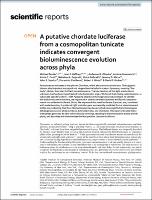Please use this identifier to cite or link to this item:
https://hdl.handle.net/20.500.12202/9616| Title: | A putative chordate luciferase from a cosmopolitan tunicate indicates convergent bioluminescence evolution across phyla |
| Authors: | Tessler, Michael Gaffney, Jean P. Oliveira, Anderson G. Guarnaccia, Andrew Dobi, Krista C. Gujarat, Nehaben Galbraith, Moira Mirza, Jeremy D. Sparks, John S. Pieribone, Vincent A. Wood, Robert J. Gruber, David F. 0000-0003-1752-0726 |
| Keywords: | luciferases bioluminescence machine learning quality of life hypothesis |
| Issue Date: | 2020 |
| Publisher: | Nature. com / Springer |
| Citation: | Tessler, M., Gaffney, J. P., Oliveira, A. G., Guarnaccia, A., Dobi, K. C., Gujarati, N. A., Galbraith, M., Mirza, J. D., Sparks, J. S., Pieribone, V. A., Wood, R. J., & Gruber, D. F. (2020). A putative chordate luciferase from a cosmopolitan tunicate indicates convergent bioluminescence evolution across phyla. Scientific Reports, 10(1), 1–11. https://doi.org/10.1038/s41598-020-73446-w |
| Series/Report no.: | Scientific Reports;10(1) |
| Abstract: | Pyrosomes are tunicates in the phylum Chordata, which also contains vertebrates. Their gigantic blooms play important ecological and biogeochemical roles in oceans. Pyrosoma, meaning "fire-body", derives from their brilliant bioluminescence. The biochemistry of this light production is unknown, but has been hypothesized to be bacterial in origin. We found that mixing coelenterazine—a eukaryote-specific luciferin—with Pyrosoma atlanticum homogenate produced light. To identify the bioluminescent machinery, we sequenced P. atlanticum transcriptomes and found a sequence match to a cnidarian luciferase (RLuc). We expressed this novel luciferase (PyroLuc) and, combined with coelenterazine, it produced light. A similar gene was recently predicted from a bioluminescent brittle star, indicating that RLuc-like luciferases may have evolved convergently from homologous dehalogenases across phyla (Cnidaria, Echinodermata, and Chordata). This report indicates that a widespread gene may be able to functionally converge, resulting in bioluminescence across animal phyla, and describes and characterizes the first putative chordate luciferase. [ABSTRACT FROM AUTHOR] Copyright of Scientific Reports is the property of Springer Nature and its content may not be copied or emailed to multiple sites or posted to a listserv without the copyright holder's express written permission. However, users may print, download, or email articles for individual use. This abstract may be abridged. No warranty is given about the accuracy of the copy. Users should refer to the original published version of the material for the full abstract. (Copyright applies to all Abstracts.) |
| Description: | Scholarly article / Open Access |
| URI: | https://hdl.handle.net/20.500.12202/9616 |
| ISSN: | 2045-2322 |
| Appears in Collections: | Stern College for Women -- Faculty Publications |
Files in This Item:
| File | Description | Size | Format | |
|---|---|---|---|---|
| Oliveira OA 2020 A putative s41598-020-73446-w.pdf | 1.2 MB | Adobe PDF |  View/Open |
This item is licensed under a Creative Commons License

